New Mammogram Recommendations: What You Need to Know

The U.S. Preventive Services Task Force, an expert panel that develops recommendations for preventive care, has suggested that all women begin routine breast cancer screening mammograms at age 40, rather than the previous recommendation of age 50. Although some other medical organizations support annual mammograms, the panel continues to advise spacing the screenings at two-year intervals.
Will this impact you?
All “cisgender women and other people assigned female at birth” who have an average risk for breast cancer and do not exhibit any troubling symptoms that might indicate breast cancer should follow these guidelines.
However, this doesn’t apply to a women who has already had breast cancer, has a genetic mutation that increases breast cancer risk, has received high-dose radiation to the chest, or has had breast lesions found in previous biopsies.
Why did the task force change its screening mammogram recommendations?
The panel’s updated recommendations were based on more recent and inclusive scientific research on breast cancer in women under 50. The panel commissioned a review of screening techniques and modeling studies to reach its conclusions even though no new clinical trial data were available and only one older trial included a significant proportion of black women. High death rates among black women were also considered by the experts: the mortality rate for black women with breast cancer in their 40s is double that of white women.
Why aren’t yearly screening mammograms recommended?
The panel’s research found no advantage to annual screening mammograms over biennial scans. According to the panel, annual mammograms are no more effective at finding stage 2 cancer and other dangerous tumors, and biennial screenings (a mammogram every other year) are thought to offer a better benefit-to-harm ratio.
Does insurance cover screening mammograms?
The law requires insurance companies to fully cover mammograms for women ages 40 to 74 who have an average risk of developing breast cancer.
For more news about breast cancer screening, click here.
Ultra-Processed Foods and Breast Cancer: Is There a Link?
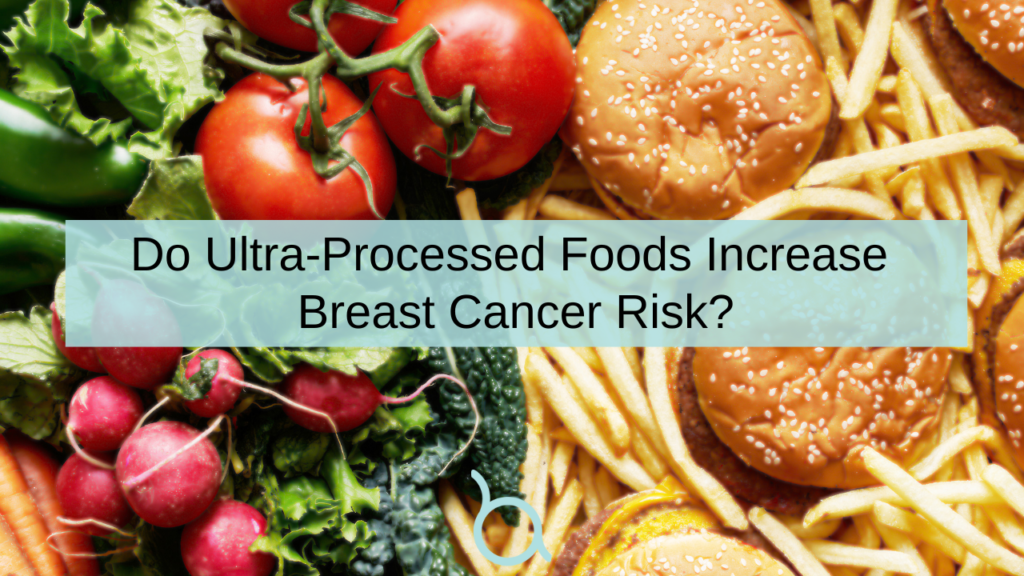
As much as 40% of cancers are estimated to be linked to lifestyle risk factors such as smoking, alcohol use, physical inactivity and diet. Several studies suggest a link between ultra-processed foods (UPFs) and an increased risk of breast cancer. A recent study published in the journal Clinical Nutrition supports a clinically relevant association between UPFs and an increased risk in several different cancers including: breast, colorectal, prostate, pancreatic, chronic lymphocytic leukemia and central nervous system tumors.
What are ultra-processed foods?
Ultra-processed foods are foods that have undergone extensive processing and contain a high amount of added sugars, fats, and other additives. Examples of ultra-processed foods include soda, energy/sport drinks, fast food, processed meats like deli meets and hot dogs, frozen dinners, chips, crackers, and sugary cereals. These foods are often high in calories and low in nutrients, making them a poor choice for a healthy diet.
Ultra-processed foods and breast cancer
Several studies suggest that consuming a diet of highly processed foods may increase the risk of developing breast cancer. Women who consume a diet high in ultra-processed foods have a higher risk of developing breast cancer than those who follow a diet rich in fruits, vegetables, and whole grains. The reason for this increased risk is thought to be due to the high levels of additives and preservatives found in ultra-processed foods. These additives have been linked to inflammation, oxidative stress, and other factors that can contribute to the development of cancer.
Nutritional tips for a healthier diet
To reduce the risk of developing cancer as much as possible, it is essential to consume a diet rich in whole foods and low in ultra-processed foods. Here are some tips to help you eat more healthily:
- Focus on whole foods: Fill your plate with fruits, vegetables, whole grains, and lean proteins.
- Read labels: When shopping for packaged foods, be sure to read the labels carefully. Look for products that are low in added sugars, saturated fats, and other unhealthy additives.
- Cook at home as much as you can: Preparing meals at home allows you to make sure the ingredients are healthy. Experiment with new recipes and try to incorporate more whole foods into your diet.
- Limit processed foods: While it may be difficult to eliminate processed foods entirely, try to limit your intake as much as possible. Choose healthier snacks like fruits, nuts, and seeds, and choose whole-grain options when buying bread, pasta, and other grains.
While the link between ultra-processed foods and breast cancer is still being studied, it is essential for you and your family to eat a healthy diet rich in whole foods to reduce the risk of developing cancer.
5 Myths About Breast Cancer, Debunked
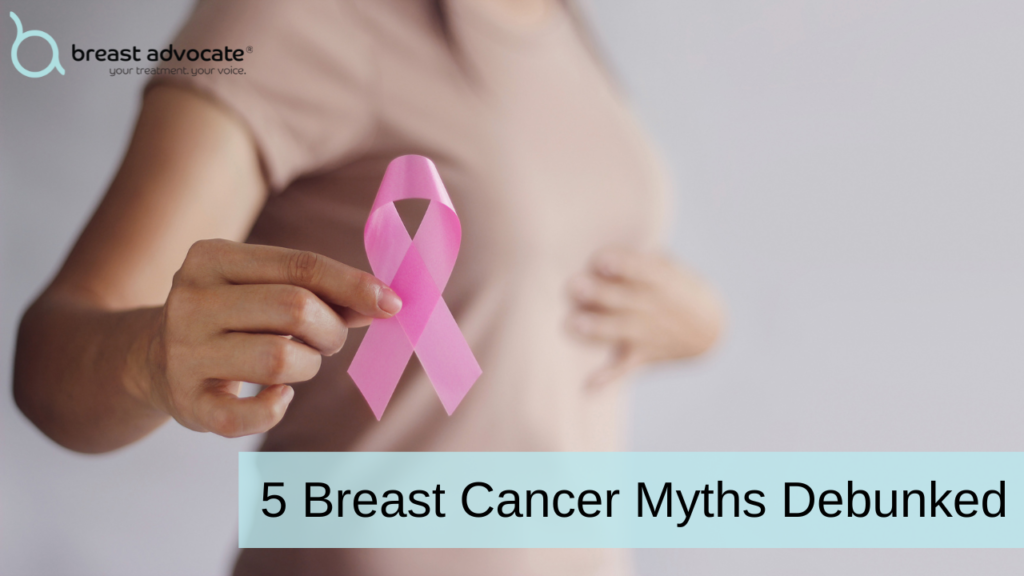
There are so many breast cancer myths circulating online: who gets it, why do they get it, or what treatment looks like…? Although breast cancer is one of the more well-known and frequently discussed cancers, there are still many misconceptions.
MYTH 1: “Breast cancer doesn’t run in my family, so I’m not at risk.”
Only 5-10% of breast cancers are thought to be hereditary, meaning they result directly from abnormal changes in certain genes passed from parent to child. Most people who develop breast cancer do not have a family history, indicating that other factors must be at work. However, it’s important to take the risk very seriously if you have a strong family history of breast cancer on either your mother’s or father’s side.
MYTH 2: “Wearing a bra causes breast cancer.”
It has been claimed that wearing an underwire-style bra could restrict the flow of lymphatic fluid out of the breast, causing toxic chemicals and other substances to build up in the breast tissue. These, in turn allegedly encourage breast cancer to develop. However, there is absolutely no evidence to back up this theory.
MYTH 3: “Men can’t get breast cancer.”
While they make up only about 1% of all cases, men can certainly develop breast cancer too. Typically, this is because of a hereditary genetic mutation in the BRCA gene, which is the most common cause of hereditary breast cancer.
MYTH 4: “Using underarm deodorant causes breast cancer.”
There are many internet claims that underarm deodorants, particularly those made with aluminum and other chemicals, are absorbed into the lymph nodes, and make their way into breast cells, increasing cancer risk. It was believed that shaving the underarms increase the risk by creating tiny nicks allowing more of the chemicals in deodorants to enter the body. According to another theory, antiperspirants prevent underarm sweating, causing the release of toxic substances from the lymph nodes into the body, therefore increasing breast cancer risk. Again, there is absolutely no reputable scientific evidence for this.
MYTH 5: “A lump in my breast means I have cancer.”
Even though most breast lumps aren’t cancerous, it’s important to have any lumps, changes, or abnormalities checked out by a doctor. Self-exams and routine mammograms are part of being proactive and aware when it comes to breast health awareness and prevention. Mammograms don’t prevent breast cancer, but they do save lives by detecting breast cancers early when it’s most easily treatable.
How to Reduce your Risk of Breast Cancer?
Although it can be very frightening to learn that 1 in 8 women are diagnosed with
breast cancer, there are steps you can take to lower your risk:
● Limit alcohol intake.
● Maintain a healthy weight.
● Get enough exercise.
● Quit smoking.
● Limit postmenopausal therapy
Know All Your Options
If you are a woman or man who has been diagnosed with breast cancer, or you are
considering surgery to decrease your risk of breast cancer – Breast Advocate® is for you. Breast
Advocate® is a free app that provides ALL your surgical options along with evidence-based
recommendations, personalized for you.
Download the latest version of the Breast Advocate® app here.
Vitamin D and Breast Cancer: Is There a Link? 
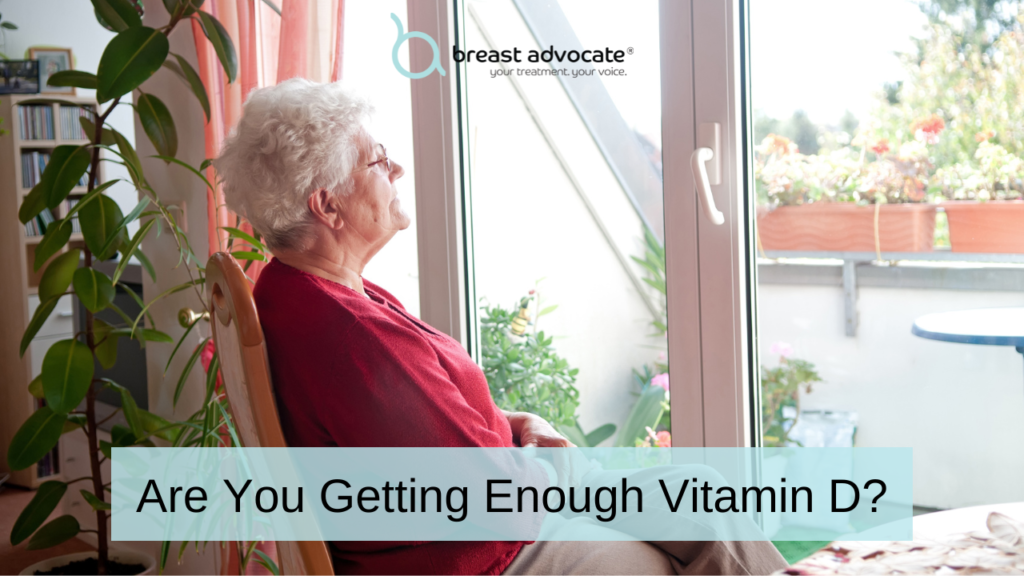
There has been some discussion about the connection between vitamin D levels and breast cancer. Recent studies show low vitamin D levels may increase the chance of cancer recurrence and sufficient vitamin D supplementation is cancer preventative. Vitamin D has additional benefits for those attempting to reduce their chance of developing breast cancer and those undergoing treatment.
What is Vitamin D?
Vitamin D is also known as calciferol or the “sunshine vitamin.” It is a fat-soluble vitamin that supports the growth of bones and teeth. Sunlight exposure helps the human body naturally produce vitamin D. The body starts producing vitamin D when ultraviolet (UV) rays from the sun are in contact with the skin. The vitamin can be consumed as a supplement and is also found in some foods.
How to Get Enough Vitamin D in the Winter
- Go outside – even if it’s cold: It’s important to get at least 5 to 15 minutes of sunlight per day – up to 30 minutes if you are darker complected.
- Include vitamin D-rich foods in your diet: Vitamin D is a fat-soluble vitamin that helps the body absorb and retain calcium and phosphorus.
- Take a vitamin D supplement: The recommended daily amount of vitamin D is 400 international units (IU) for children up to age 12 months, 600 IU for people ages 1 to 70 years, and 800 IU for people over 70 years.
- Pay attention to calcium: One of vitamin D’s major roles is to help you absorb calcium. Your body needs calcium to build strong bones when you’re young and keep bones strong as you age. Calcium is necessary for everyone, but it’s especially important for women.
- Talk to your doctor about your medications: Sometimes low sunlight isn’t the only problem. Certain medications can hurt your vitamin D levels.
Foods High in Vitamin D
The following list of foods includes vitamin D:
- Fatty fish (trout, salmon, tuna, mackerel, sardines)
- Fish liver oils
- Beef liver
- Egg Yolks
- Mushrooms
- Shrimp
Vitamin D is frequently added to the following foods:
- Milk or milk substitutes
- Cheese and juice
- Yogurt
Breast Cancer Recurrence
The correlation between vitamin D levels and breast cancer is a subject of debate among scientists. One explanation is that there are multiple research variables, including different cutoff values used in studies to gauge vitamin D deficiency.
Many studies have revealed that a significant portion of those who are given breast cancer diagnoses have poor vitamin D levels. People with low vitamin D levels may be more prone to cancer development and recurrence (metastasis).
According to one study, 34% of the control group had vitamin D levels above 20 ng/ml at the time of diagnosis, while 45% of those with breast cancer did not. According to research, vitamin D contains anticarcinogenic characteristics, which may help prevent the growth of cancer cells.
Overall, Health and Wellness
Vitamin D deficiency can be harmful to your overall health. Your body needs vitamin D to support cardiovascular (heart), reproductive, immune, nervous, and skeletal muscle function.
Some specific roles of vitamin D in the body include:
- Bone growth and repair
- Supporting muscle movement allows the brain to receive signals from nerves
- Decreasing inflammation
- Building immunity
- Promoting cell division and growth
- Supporting glucose metabolism
More Information
To learn more about vitamin D and breast cancer, visit the U.S. National Cancer Institute.
Coping with the Stress of Cancer During the Holidays
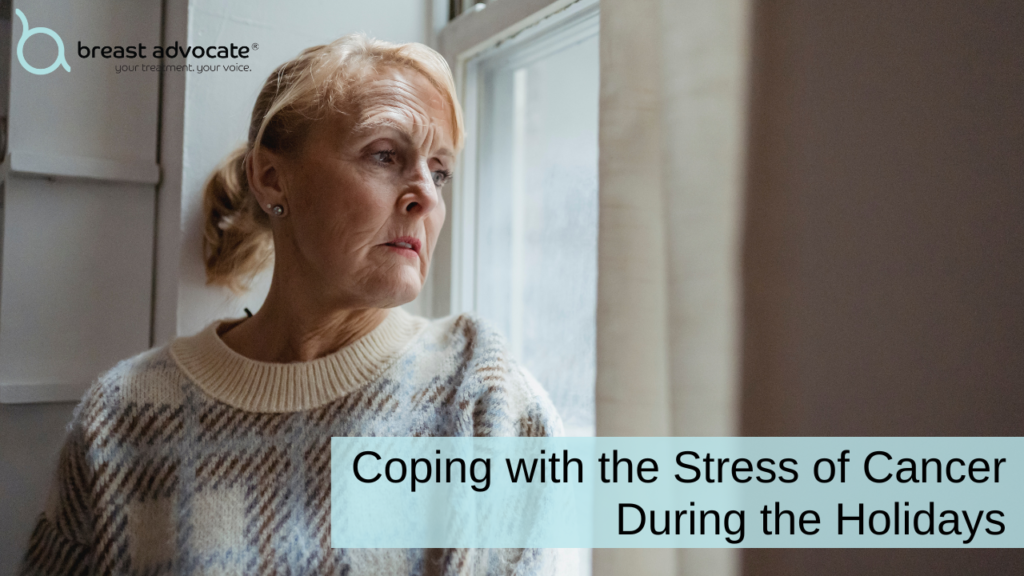
Holidays are traditionally viewed as a time to celebrate. During this season, many people enjoy spending time with family and friends, exchanging gifts, and celebrating traditions.
However, according to experts, it is common for breast cancer patients and their loved ones to have trouble coping with the stress of cancer during the holidays and feel “out of touch” with the rest of the world during this time.
Tips to Help Cope with Cancer During the Holidays
1. Prioritize yourself: Accept where you are and take the pressure off yourself. If you are feeling tired and less social, know those feelings are normal. “Our stress hormones are in high gear when we’re going through cancer treatment,” shares Patricia Ganz, M.D., Director of Cancer Prevention and Control Research.
When faced with stressful situations, people often have high expectations for themselves and others. Let go of any expectations and allow yourself to be where you are emotionally and physically.
2. Adjust your traditions: Decide which holiday traditions are most important to you and adjust them to fit your needs. If you love hosting holiday parties, consider getting food delivered from a nearby restaurant and asking for help with cleaning and decorating. Set a holiday budget and shop online. These small changes will help you enjoy the Christmas season without becoming stressed.
3. Enjoy every moment: Focus on making new traditions with your loved ones instead of focusing on how cancer has changed a holiday or special occasion. If you can’t make it to every event, use FaceTime or Zoom to stay in touch with your friends and family.
4. Surround yourself with support: Communicate what you need physically and emotionally and don’t close yourself off from relationships. Talking through your emotions is important. It’s okay to let yourself cry and feel all the feelings. Find a significant other, friend, or family member who can help make the holidays as pleasurable as possible.
For Family and Friends
Managing your own emotions and worries while caring for someone with cancer during the holidays can be difficult to navigate. Here are a few things to keep in mind:
1. Discuss expectations: It’s important to listen and be respectful of your loved one’s needs this holiday season.
2. Take the pressure off: Create an environment where your friend or loved one feels comfortable sharing their needs during this time. Continue to offer invitations and make plans, but don’t be offended if they aren’t able to attend.
3. Recognize when your loved one needs support: Pay special attention to their emotions. “You don’t even have to ask someone directly if they are depressed—you can ask about mood, sadness, and symptoms that may be indicators of depression, such as fatigue, trouble falling asleep, and trouble concentrating,” explains Ganz.
Let them know they are not alone and that it’s okay to ask for help. There are many resources available for patients and caregivers. Contact your loved one’s healthcare team for more information to ensure you are both getting the support you need.
You can find more information on managing stress during the holidays here.
Exercising During Chemotherapy: Why it’s Important and How to Start
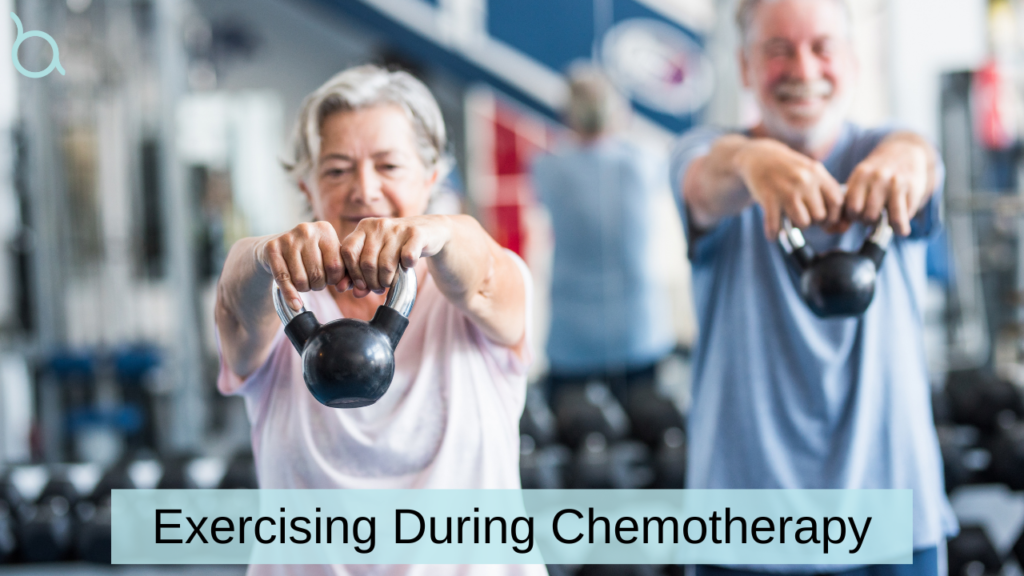
According to a recent study in JACC, exercising during chemotherapy can greatly improve physical and mental health. Exercise is a crucial part of any cancer treatment plan. However, it is important to take your time and be patient with yourself as you start to gradually increase your activity levels. Let your body be your guide.
Even if you weren’t active before your cancer diagnosis, a fitness program that meets your individual needs can help you get moving safely and effectively. Physical activity can also help you cope with the common side effects of chemo and decrease your risk of new cancers in the future.
Benefits to Exercising During Chemotherapy
If you feel well enough to start exercising, getting more physically active can improve the body’s response to treatment regardless of the stage or type of cancer. Regular exercise has been shown to:
- Reduce treatment-related fatigue
- Maintain physical strength
- Reduce feelings of anxiety and depression
- Reduce the amount of recovery time needed in the hospital
- Help maintain weight
- Improve quality of sleep
Exercising During Breast Cancer Treatment
Patients should start slowly and increase activity gradually. Always talk to your doctor before starting a program during cancer treatment. Start with walking and once you feel comfortable, you can work your way up to more brisk walks. If you feel you can push it more, try increasing amounts of aerobic exercise like running, swimming, or cycling.
After treatment, it will take time to return to your desired fitness level. Listen to your body and take rest days as you need them. Your healthcare team should be able to advise you on the best workout regimen for you or provide you with the guidance you need. You may have access to a local certified cancer exercise therapist who can create the ideal exercise plan for you.
As a general rule, the CDC recommends at least 2 days of full-body strength training each week for healthy adults, so consider using this as your long-term goal. A strength training program can include free weights, cardio machines, resistance bands, and your own body weight.
Your ideal individual exercise plan to start with will depend on:
- The type of cancer you have
- The treatments being used
- The side effects you are experiencing
- What you’re able to do physically
How to Exercise Safely During Breast Cancer Treatment
Make sure you start slowly, listen to your body, and drink plenty of fluids. Staying well hydrated is especially important if you are still going through chemotherapy, or experiencing side effects from your treatment.
What to Ask Your Healthcare Team
- What type of exercise program do you suggest for me?
- Do I need to refrain from doing any exercises while receiving treatment?
- Do you recommend cancer rehab for me? If so, can you provide a referral?
- Are there any exercises I can do at home?
As you get going, please remember everyone is different. This isn’t a competition. Just start moving and do what you can. Be patient with yourself and the rest will come. You’ve got this.
***
Co-created by leading specialists and patient advocates, Breast Advocate® is a free breast cancer surgery app that provides ALL your surgical options along with evidence-based recommendations, personalized for you. Download our free app today!
Breast Cancer Recurrence Rates Low with Nipple-Sparing Mastectomy
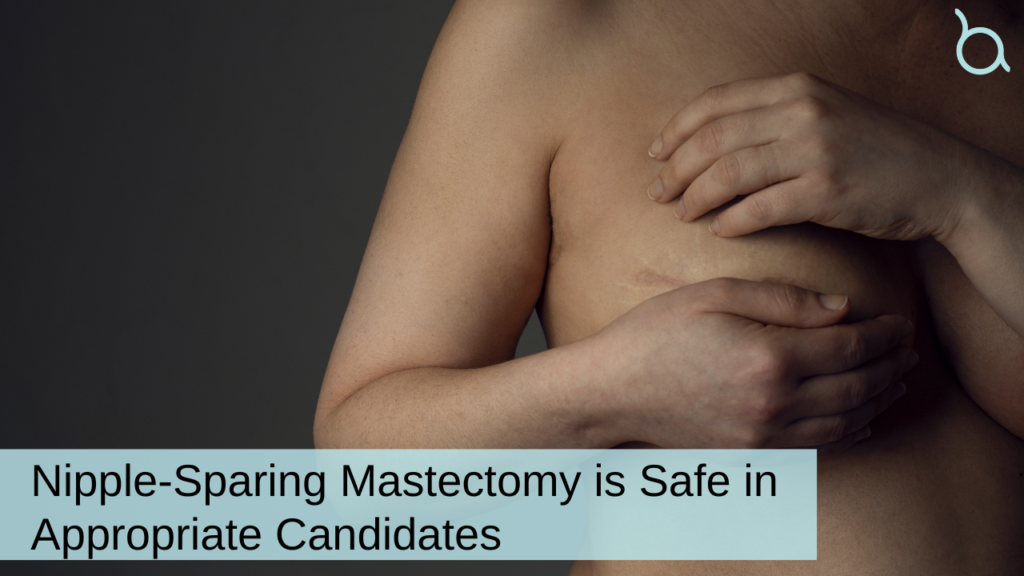
A recent study published in Plastic and Reconstructive Surgery confirms that nipple-sparing mastectomy (NSM) is a very safe procedure when performed in appropriate patients. Preserving the nipple-areola complex at the time of a mastectomy is associated with a very low risk of recurrence, just over 3%.
“Nipple-sparing mastectomy remains a viable option in the appropriately indicated patient with regards to long-term cancer recurrence,” state the researchers.
What is a Nipple Sparing Mastectomy?
A nipple-sparing mastectomy (NSM) preserves the nipple and areola along with the entire skin envelope. Only the underlying breast glandular tissue is removed. Nipple-sparing mastectomy significantly improves cosmetic results when combined with immediate breast reconstruction and is oncologically safe when performed in appropriate candidates. It can also improve the return of sensation in some patients.
The Research Behind the Study
120 patients undergoing nipple-sparing mastectomy for breast cancer treatment were evaluated for breast cancer outcomes. The analysis included a total of 126 therapeutic NSM procedures. Prophylactic (preventive) NSM procedures to reduce the risk of breast cancer in women at high genetic risk were excluded.
At a median follow-up of 10 years after NSM, the analysis showed a very low risk of recurrent cancer: 3.33% per patient and 3.17% per reconstructed breast. Of the four patients who developed a recurrence, two had local recurrences (breast-only) and two had cancer spread beyo0nd their breast (locoregional recurrence).
The recurrence risk was higher in women who’s initial cancer involved the lymph nodes. However, there were no demographic, surgical, or tumor-related variables that predicted the risk of recurrent breast cancer.
Reassuring Findings but Surveillance Still Important
The confirmation of favorable long-term cancer control is crucial because of the increased use of NSM and immediate reconstruction in women with breast cancer. “Patients with nipple-sparing mastectomies have had low locoregional recurrence rates in a retrospective review of patients with a median follow-up of 10 years,” researchers conclude. “Despite low rates of recurrence, close surveillance remains important to continually assess for long-term safety of nipple-sparing mastectomy.”
To learn more about Nipple-Sparing Mastectomy, download the FREE Breast Advocate App today!
Sexual Health Issues Common Among Women with Breast Cancer

It is common for women being treated for breast cancer to experience changes that affect their sexual health during, and after treatment, according to a recent study published in Acta Oncologica.
Just under 700 cancer patients were included in the study. Over 60% reported having some sort of sexual dysfunction. Lymphoma and cervical, ovarian, breast, and brain cancers were among the cancer types represented. In the cancer group, the mean age was 34.5 years, while in the control group, it was 29.7 years. The majority of people in both groups were heterosexual (93% in both groups) and had a partner (85% in the cancer cohort and 81% in the control cohort).
Overall, 63% of patients with cancer and 53% of the control group reported sexual dysfunction in at least 1 of the following:
- satisfaction with sex life
- interest in sexual activity
- ability to orgasm
- pleasure with orgasm
- vaginal lubrication
- vaginal discomfort
- vulvar discomfort (clitoral or labial)
“A majority of women diagnosed with cancer before the age of 40 experience sexual dysfunction, and they do so to a significantly higher extent than young women of the general population,” the researchers concluded. “Women with gynecological and breast cancers reported more sexual dysfunction than the general population…. Our results underscore the need to routinely assess sexual health in clinical care and follow-up.”
How to manage sexual health issues
You’re not alone if you’re struggling with issues affecting your sexuality. Following a breast cancer diagnosis, sex and intimacy can be challenging for many women.
Below are ways to manage common sexual health issues:
- Learn about the side effects of treatment: hormone therapy may cause a loss of desire as well as vaginal changes that can make sex painful.
- Get help from a health care professional: many physical symptoms that affect your sex life or sexuality can be treated by your doctor.
- Talk with your partner: open communication between you and your significant other is very important in getting back your sexuality.
- Exercise: physical activity can help improve sexuality and body image and reduce anxiety and stress.
Learn more about sexual health needs after breast cancer.
Talking with your healthcare team about sexual health issues
Make a list of questions to ask your doctor or nurse as you consider the changes that treatment has made in your life. Think about including these on your list:
- What sexual issues are common?
- What sexual issues might I have during treatment?
- When will these changes occur?
- How long may these issues persist? Will they last forever?
- How can these issues be avoided, dealt with, and/or managed?
- Should I consult with a specialist to learn more?
- Are there support groups that you recommend?
For more on body image and sexuality after breast cancer, head to the American Cancer Society.
Breast Cancer-Related Fatigue Can Impact Your Balance
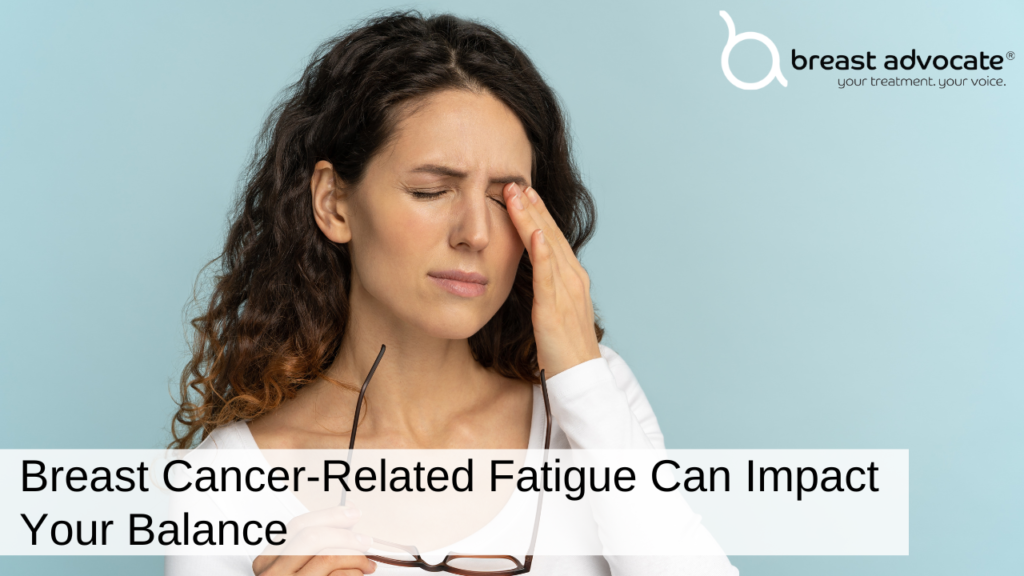
According to a recent study, persistent cancer-related fatigue (CRF) seems to affect balance, independent of chemotherapy-induced peripheral neuropathy (CIPN) symptoms.
Cancer Fatigue
Cancer-related fatigue is the most common side effect of cancer treatment. The American Cancer Society estimates between 80% and 100% of cancer patients experience fatigue.
As a result of cancer fatigue, individuals constantly feel exhausted and even a good night’s sleep doesn’t help.
Cancer fatigue can last for weeks, months, or years and may even continue after you finish your treatment. There are several factors that can cause cancer fatigue including:
- Effects of cancer itself
- Cancer treatment: chemotherapy, radiation therapy, immunotherapy, etc.
- Anemia (low blood counts)
- Pain
- Prolonged extremes of emotion
- Lack of sleep
- Poor nutrition
- Lack of exercise
Balance Problems
Another typical side effect that can occur after breast cancer treatment are balance issues. In addition to having difficulty walking and balancing, many people find it hard to move as they did before treatment, which increases their risk of falling.
Neuropathy
Neuropathy is the pain or discomfort caused by damage to the nerves of the peripheral nervous system. Damage to those nerves can affect how the body sends signals to muscles, joints, skin, and internal organs causing pain, tingling, and numbness.
Neuropathy caused by chemotherapy is the main cause of balance issues and other physical problems among breast cancer patients.
The Research Behind the Study
The study included 43 women between the ages of 30 and 85 who had been diagnosed with stage I to stage III breast cancer. All the women had finished their chemo treatment about 3.5 years before joining the study.
The researchers performed physical function tests on the women. These tests included simple tasks such as balancing on one leg and standing up from a sitting position repeatedly. Researchers measured how much the women swayed, if any, after each test. The degree of swaying revealed the severity of balance issues the women had.
Women were asked to complete a survey asking if they had fatigue and how severe it was. The average fatigue score was 43.15, about 54% of the women had neuropathy in their feet. On a scale of 1 to 6, the average severity was 2.3.
“Our results…indicate that [cancer-related fatigue], even several years following exposure to chemotherapy, may distinctly influence balance independent of a patient’s [chemotherapy-induced peripheral neuropathy] status,” explain the researchers. “This finding is important since persistent [cancer-related fatigue] affects up to 30% of individuals well beyond one year following completion of primary cancer treatment.”
What This Means
The study’s findings are concerning; however, they are important for anyone who has received chemotherapy for breast cancer.
Even if you don’t have neuropathy, you may experience balance issues if you have fatigue-like symptoms. You might experience even worse balance during physical tasks such as climbing stairs or walking for long periods of time.
Activities you can do to help improve your balance include:
- Yoga
- Light exercise to improve balance
- Acupuncture
- Working with a physical therapist or trainer
Learn more about cancer fatigue and how to cope here.






